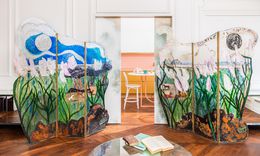
Paire de paravents: "Lune Claire et Lune Sombre "(Chiens errants à Beau Vallon, Ile Maurice)
Genevieve Bonieux
Design - 210 x 200 x 1 cm Design - 82.7 x 78.7 x 0.4 inch
$16,667
A folding screen is a piece of furniture that consists of a portable, folding partition. It can be used in a myriad of ways and for an array of reasons. The object provides privacy in a space, prevents air drifts, and in some cultures, it is used as a form of protection against evil spirits. A folding screen is composed of adjustable, foldable panels, made out of an array of materials. It typically has a wooden structure, adorned by stretched fabric or textiles.
Looking back at history, folding screens were seen in the homes of nobles throughout China during the Zhou dynasty. At first, the item was set in a fixed position, remaining in a single place, as opposed to a portable partition. It wasn't until the Han dynasty that the piece of furniture became a movable object made from wood, connected by metal hinges. These panels were often decorated with paint. The screens were used for various purposes. Some panels were placed inside a room to provide privacy. Others displayed folded screens in an uneven or broken line, to stop spirits from traveling through home-dwellings. It was believed that certain spirits could move through spaces in straight lines; therefore, a screen left in a zig-zag at the entry of a home prevented souls from entering the house, while also conserving the inside temperature.
During the seventh century, folding screens began to appear throughout Japan and Korea. In Japan, they embraced adjustable partitions made of paper, silk, wood, textile materials, and hinges. Japanese folding screens from this period are known for their illustrations and stories that are read from right to left. In Korea, similarly to Japan, screens were highly decorative and made with high-quality materials.
Eight centuries later, during various expeditions to Asia, British travelers discovered folding screens and brought them back to Europe. In the centuries that followed, neighboring European nations followed suit, including the Dutch and the French. Because of this, folding screens spread throughout Europe. The use of the object was widespread from the 16th century, moving forward. However, by the beginning of the 19th century, there was a decline in the use of the object. Things changed a few decades later during a boom of Japanese-inspired cultural material spread throughout France, during the reign of Napoleon III. In the 20th century, with the beginning of the modern heater, folding screens became decorative objects rather than a means to maintain the temperature of a space.
Discover the historical impact as well as its evolving functionality and aesthetic nature in our collection of folding screens!
Save your search and find it in your favorites
Save your search to find it quickly
Saved search
Your search is accessible from the favorites tab > My favorite searches
Unsaved search
A problem occurred

Design - 210 x 200 x 1 cm Design - 82.7 x 78.7 x 0.4 inch
$16,667

Choose your preferences
The art is yours
The art is yours